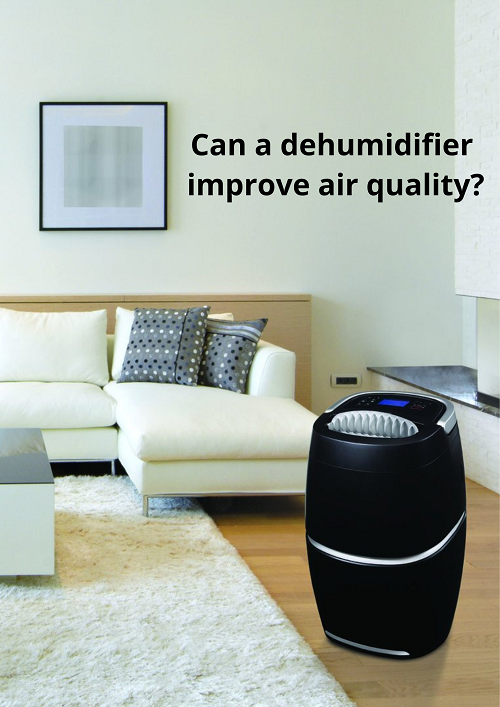A dehumidifier improves the quality of your air by lowering the humidity. It removes water vapor from the air, which improves indoor air quality in several ways. Dehumidifying the air improves thermal comfort, relieves respiratory problems, reduces the presence of allergens, and reduces musty odor. Additionally, its air filter removes airborne dust, pollen and mold spores.

According to the United States Environmental Protection Agency (US EPA), indoor air is often 2 to 5 times more polluted than outdoor air (source). Ventilation is key to maintaining healthy indoor air. However, if your indoor air has a humidity above the optimal 40-50%, your air is more stagnant and will not easily be ventilated. A dehumidifier makes the air less humid and stagnant, allowing for better ventilation.
For specialized filtering of airborne particles and gases, an air purifier is required. However, the dust filter on a dehumidifier already helps a lot versus common airborne particles. At the end of this article, I added some links to my articles about air quality and air purifiers.

What does a dehumidifier do?
A dehumidifier uses a fan to run air through the device. This air first goes through a filter that removes airborne particles. Then the device removes water vapor from the air before releasing the dried air on the other side.
I wrote an in-depth article about how dehumidifier work exactly. Here, I go into the different workings of both types of dehumidifiers as well. You can find it here:
How a dehumidifier improves indoor air quality
Because a dehumidifier removes particle and water vapor, it greatly improves air quality. Leading to:
- improved thermal comfort
- less dampness
- reducedcondensation
- reduced presence of allergens like mites and molds
- less musty odor
- reduced airborne dust
- lowering the chances of mold growth
- relieving respiratory problems like asthma and COPD
How a dehumidifier improves thermal comfort
How comfortable you feel in the air around you is not only based on the temperature of the air. The relative humidity of the air plays a crucial role as well. Your thermal comfort therefore depends on the air temperature and the level of relative humidity (the amount of water vapor in the air).
When the relative humidity of the air is above 60%, it feels less comfortable. Lowering the relative humidity (RH) of humid air to the recommended 30 to 60 % RH optimizes your thermal comfort.
Humidity influences your thermal comfort in the following way:
- high moisture levels increase the feeling of being cold when the temperature is low, and;
- high moisture levels increase the feeling of heat when the temperature is high
So, high moisture levels both increase the feeling of being cold as well as that of being warm. How does that work?

Feeling too hot: high temperatures and high humidity
When the temperature is high, your body starts to sweat in order to lose its heat and cool down. However, sweating is done by evaporating moisture from your skin. This evaporation is more complicated when the amount of moisture in the air is high.
Because you cannot easily lose your body heat by evaporating sweat, your feeling of being too hot will increase.
Feeling cold: low temperature with high humidity
When the temperature is low and you have high humidity, you will not sweat to lose heat. However, the moisture in the air makes the air wetter, and wet air touching your skin makes you feel similar to losing heat through sweating.
Additionally, your body heat creates a warm pocket of air between your skin and your clothes that keeps you warm. However, when the air has a high moisture content, your clothes contain more moisture than in dry air. This then works similarly to sweating. Your body heat is evaporating the water in your clothes, making you lose the heat.
For an in-depth explanation of humidity and how it affects our perception of temperature, I recommend reading my article:
Lowering humidity can relieve respiratory problems
Many respiratory (breathing and lung) problems are worsened by poor air quality. Since indoor air quality is often much worse than outdoor air, running devices such as an air purifier and a dehumidifier can greatly improve our well-being indoors.
High humidity can lead to an increase in respiratory issues. It can lead to more frequent coughing and having a runny nose. (source)
On top of that, it can increase the severeness and frequency of existing respiratory problems such as:
- asthma
- bronchitis, and
- COPD
Air that is excessively humid feels harder to breathe because it triggers nerves in your lungs that tighten your airways, making them more narrow. Therefore, people with respiratory problems will likely experience more issues when the air is too humid.
Additionally, high humidity allows allergens like mites and molds to thrive. This will also increase the chances of asthma and bronchitis triggers.

Dehumidifiers help reduce allergens
Many allergens are in some way related to your air humidity. For example, high humidity increases the presence of allergens like:
- mold and mildew
- (dust) mites
Normally, relative humidity between 30 and 60 % is recommended. When you suffer from allergies, however, narrowing the humidity levels to 40 – 50 % is optimal to ease symptoms. (source)
Mold and mildew
When mold and mildew are allowed to grow, they start to produce more and more spores that are released into the air. This increases the number of spores in the air above natural background levels and can trigger allergic reactions.
Dust mites
Dust mites live in carpets, bedsheets, curtains, etc. They live off of dust and prefer high humidity levels of 70%. The excrements and dead bodies of mites are common allergens.
You can reduce the number of dust mites present in your home by lowering the air humidity with a dehumidifier.
Dehumidifiers reduce mold and mildew
Molds and mildew thrive at elevated humidity levels (60% and higher). There are thousands of mold spores in the air at all times and they can grow on any surface as long as there is sufficient moisture present. Therefore, they are most common in the bathroom and basement.
However, when the humidity of your air increases, it will start to grow anywhere in the house. As discussed earlier, mold and mildew can release allergens into the air, causing respiratory problems. However, mold and mildew will also slowly eat away at the surface on which they are growing. This means that wood and paper will be destroyed over time. However, it can also weaken the structural integrity of our home, often without us knowing.
Reducing your air humidity levels is the best way to prevent their growth.
The following picture was taken in my own bedroom where I found mold due to condensation on the wall. As you can see, dark spots are forming where water droplets are present. If left unchecked, these spots will grow in numbers rapidly over the course of a few days.

Dehumidifiers prevent musty odor
High humidity can lead to a musty odor. Therefore, using a dehumidifier helps prevent these odors. The main causes of a musty odor are the presence of high amounts of mold spores and suspended odor-causing particles. Mold spores are more plentiful in humid conditions, and odor-causing particles linger in the stagnant humid air.
Due to high levels of humidity, molds and mildew can grow more easily and release more spores. This leads to an increase of spores above normal background levels. High amounts of airborne spores contribute to a musty smell.
Additionally, humid air is relatively stagnant compared to dry air. This leads to less airflow and poorer ventilation. Because of this, any particles that smell bad tend to linger in the air much longer.
Dehumidifiers remove airborne dust
Dehumidifiers help remove dust particles that are floating in the air. They have a simple dust filter that collects these (relatively large) particles when air is sucked into the device. This prevents not only the machine from dust build-up, but also helps reduce airborne dust.
The efficiency of the dust filter depends on the type of filter that is included. Most dehumidifier have a regular medium-rated filter while other have a more efficient HEPA filter (High Efficiency Particulate Air).
However, before it has removed all the dust from the air, it can introduce more dust into the air. This happens because the dehumidifier makes the air in the room move with its fan. Because of this increased air movement, dust that settled down on surfaces becomes airborne again.
Therefore, I recommend dusting the room before running the dehumidifier as well as trying to not be in the room before the dehumidifier has run for some time. In this way, most of the air has been through the machine already, and the filter has had a chance to remove the dust particles.
If you are looking for more information on purifying your air, I recommend taking a look at one of my articles:
– How to know if you need an air purifier? (+what it does and doesn’t do)
– How to naturally purify the air in your house (a critical review + what actually works)
– Do house plants improve indoor air quality? (surprising results)
– Do air purifiers remove odor? (required filters and specifications)
– Do air purifiers dry the air? (or why does it feel that way?)


